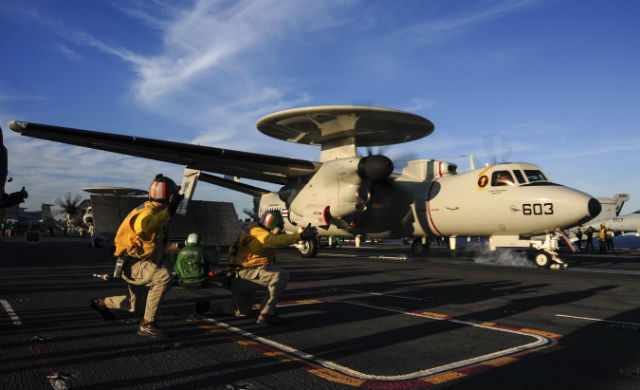The US Navy on 10 October announced the initial operating capability of its Northrop Grumman E-2D Advanced Hawkeye airborne early warning aircraft.
The E-2 radar, communication and command and control aircraft was first introduced in 1964 to improve the radar range of aircraft carrier strike groups at sea.
The E-2D improves upon its predecessors with a passive electronically scanned radar array, more powerful datalinks and a fourth crew member to handle mission data.
“This is not an E-2C with upgrades,” says Cmdr John Hewitt, commanding officer of VAW-120, the E-2 squadron in charge of training and transition of units from the C-model to D-model Hawkeyes. “This a brand new platform. There are some legacy systems shared between the two platforms, but those similarities end very quickly.”
The E-2C was designed to operate specifically in a maritime environment, so it “has its limitations over land and littoral environment”, Hewitt says. “With the E-2D we have great improvement to see contacts – air and surface – over land, over water. It really doesn’t matter. The aircraft does not care about its operating environment.”

US Navy
The most notable upgrade is the range and power of the aircraft’s radar over its predecessor. The Lockheed Martin APY-9 system can see smaller targets at greater ranges in more environments than older systems. The solid state, rotating radar also can detect cruise missiles over ground clutter.
“The radar in the E-2D can see a very small radar cross section targets in any operating environment,” Hewitt says. “If my radar has line of sight to that target, we will see it over the E-2C.”
At the ranges the E-2D can reach, which officials did not specify, the aircraft can also support the naval integrated fire control-counter air strategy, allowing the aircraft to act as an over-the-horizon target designator for long-range munitions.
The D-model’s upgraded radars and associated equipment add about 907kg (2,500lb) to the aircraft, which required Northrop to redesign 60% of the fuselage, says Bart Legrone, vice-president of E-2/C-2 programmes at Northrop.
The E-2C has a maximum trap weight – the heaviest it can be to safely land on a carrier – of 21,100kg while the E-2D can land aboard ship loaded to 22,500kg. The E-2D was outfitted with beefed up Rolls-Royce T56-427A turboprop engines to accommodate the added weight.
Northrop has delivered 15 E-2Ds of 52 currently contracted, though the navy’s programme of record is 75 aircraft. A 16th aircraft should be delivered by the end of the year, Legrone said. The navy will begin phasing out legacy E-2Cs in 2017. By 2025, all Hawkeye squadrons should be equipped with the D-model aircraft.
The first squadron of five E-2Ds, VAW-125, already is scheduled to deploy aboard the aircraft carrier USS Theodore Roosevelt in 2015.
Recognising the long-term need for an AEW aircraft, room for growth was built into the E-2D, says Capt John Lemmon, the navy’s E-2/C-2 airborne tactical data systems programme manager. The Northrop C-2 Greyhound is primarily a cargo aircraft that ferries supplies to and from carriers.
“As long as we’ve got aircraft carriers out there forward deployed, we’re going to need the Hawkeye,” he says.
Source: FlightGlobal.com



















